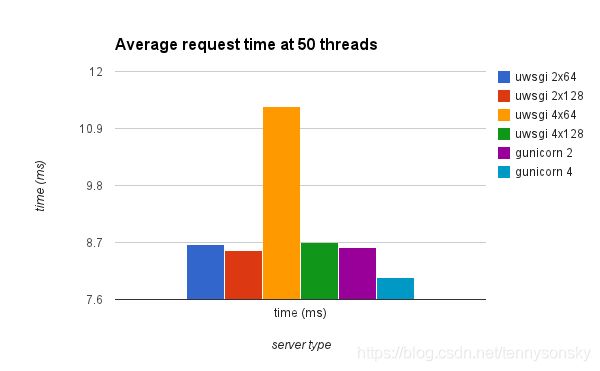Python Web开发最难懂的WSGI协议,到底包含哪些内容?
本文转自: https://segmentfault.com/a/1190000011365430
我想大部分Python开发者最先接触到的方向是WEB方向(因为总是有开发者希望马上给自己做个博客出来,例如我),既然是WEB,免不了接触到一些WEB框架,例如Django,Flask,Torando等等,在开发过程中,看过一些文档总会介绍生产环境和开发环境服务器的配置问题,服务器又设计web服务器和应用服务器,总而言之,我们碰到最多的,必定是这个词 — WSGI。
接下来的文章,会分为以下几个部分:
- 1 WSGI介绍
- 1.1 什么是WSGI
- 1.2 怎么实现WSGI
- 2 由Django框架分析WSGI
- django WSGI application
- django WSGI Server
- 3 实际环境使用的wsgi服务器
- gunicorn
- uwsgi
- bjoern
- 4 WSGI服务器比较
1 WSGI介绍
1.1 什么是WSGI
首先介绍几个关于WSGI相关的概念
WSGI: 全称是Web Server Gateway Interface,WSGI不是服务器,python
模块,框架,API或者任何软件,只是一种规范,描述web server如何与web application通信的规范。server和application的规范在PEP 3333中有具体描述。要实现WSGI协议,必须同时实现web server和web application,当前运行在WSGI协议之上的web框架有Torando,Flask,Django
uwsgi: 与WSGI一样是一种通信协议,是uWSGI服务器的独占协议,用于定义传输信息的类型(type of information),每一个uwsgi packet前4byte为传输信息类型的描述,与WSGI协议是两种东西,据说该协议是fcgi协议的10倍快。
uWSGI: 是一个web服务器,实现了WSGI协议、uwsgi协议、http协议等。
WSGI协议主要包括server和application两部分:
- WSGI server负责从客户端接收请求,将request转发给application,将application返回的response返回给客户端;
- WSGI application接收由server转发的request,处理请求,并将处理结果返回给server。application中可以包括多个栈式的中间件(middlewares),这些中间件需要同时实现server与application,因此可以在WSGI服务器与WSGI应用之间起调节作用:对服务器来说,中间件扮演应用程序,对应用程序来说,中间件扮演服务器。
WSGI协议其实是定义了一种server与application解耦的规范,即可以有多个实现WSGI server的服务器,也可以有多个实现WSGI application的框架,那么就可以选择任意的server和application组合实现自己的web应用。例如uWSGI和Gunicorn都是实现了WSGI server协议的服务器,Django,Flask是实现了WSGI application协议的web框架,可以根据项目实际情况搭配使用。
以上介绍了相关的常识,接下来我们来看看如何简单实现WSGI协议。
1.2 怎么实现WSGI
上文说过,实现WSGI协议必须要有wsgi server和application,因此,我们就来实现这两个东西。
我们来看看官方WSGI使用WSGI的wsgiref模块实现的小demo,有关于wsgiref的快速入门可以看看这篇博客
def demo_app(environ,start_response):
from StringIO import StringIO
stdout = StringIO()
print >>stdout, "Hello world!"
print >>stdout
h = environ.items(); h.sort()
for k,v in h:
print >>stdout, k,'=', repr(v)
start_response("200 OK", [('Content-Type','text/plain')])
return [stdout.getvalue()]
httpd = make_server('localhost', 8002, demo_app)
httpd.serve_forever() # 使用select
实现了一个application,来获取客户端的环境和回调函数两个参数,以及httpd服务端的实现,我们来看看make_server的源代码
def make_server(
host, port, app, server_class=WSGIServer, handler_class=WSGIRequestHandler
):
"""Create a new WSGI server listening on `host` and `port` for `app`"""
server = server_class((host, port), handler_class)
server.set_app(app)
return server
接受一系列函数,返回一个server对象,实现还是比较简单,下面我们来看看在django中如何实现其自身的wsgi服务器的。
下面我们自己来实现一遍:
WSGI 规定每个 python 程序(Application)必须是一个可调用的对象(实现了__call__ 函数的方法或者类),接受两个参数 environ(WSGI 的环境信息) 和 start_response(开始响应请求的函数),并且返回 iterable。几点说明:
- environ 和 start_response 由 http server 提供并实现
- environ 变量是包含了环境信息的字典
- Application 内部在返回前调用 start_response
- start_response也是一个 callable,接受两个必须的参数,status(HTTP状态)和 response_headers(响应消息的头)
- 可调用对象要返回一个值,这个值是可迭代的。
# 1. 可调用对象是一个函数
def application(environ, start_response):
response_body = 'The request method was %s' % environ['REQUEST_METHOD']
# HTTP response code and message
status = '200 OK'
# 应答的头部是一个列表,每对键值都必须是一个 tuple。
response_headers = [('Content-Type', 'text/plain'),
('Content-Length', str(len(response_body)))]
# 调用服务器程序提供的 start_response,填入两个参数
start_response(status, response_headers)
# 返回必须是 iterable
return [response_body]
# 2. 可调用对象是一个类
class AppClass:
"""这里的可调用对象就是 AppClass 这个类,调用它就能生成可以迭代的结果。
使用方法类似于:
for result in AppClass(env, start_response):
do_somthing(result)
"""
def __init__(self, environ, start_response):
self.environ = environ
self.start = start_response
def __iter__(self):
status = '200 OK'
response_headers = [('Content-type', 'text/plain')]
self.start(status, response_headers)
yield "Hello world!\n"
# 3. 可调用对象是一个实例
class AppClass:
"""这里的可调用对象就是 AppClass 的实例,使用方法类似于:
app = AppClass()
for result in app(environ, start_response):
do_somthing(result)
"""
def __init__(self):
pass
def __call__(self, environ, start_response):
status = '200 OK'
response_headers = [('Content-type', 'text/plain')]
self.start(status, response_headers)
yield "Hello world!\n"
服务器程序端
上面已经说过,标准要能够确切地实行,必须要求程序端和服务器端共同遵守。上面提到, envrion 和 start_response 都是服务器端提供的。下面就看看,服务器端要履行的义务。
- 准备 environ 参数
- 定义 start_response 函数
- 调用程序端的可调用对象
import os, sys
def run_with_cgi(application): # application 是程序端的可调用对象
# 准备 environ 参数,这是一个字典,里面的内容是一次 HTTP 请求的环境变量
environ = dict(os.environ.items())
environ['wsgi.input'] = sys.stdin
environ['wsgi.errors'] = sys.stderr
environ['wsgi.version'] = (1, 0)
environ['wsgi.multithread'] = False
environ['wsgi.multiprocess'] = True
environ['wsgi.run_once'] = True
environ['wsgi.url_scheme'] = 'http'
headers_set = []
headers_sent = []
# 把应答的结果输出到终端
def write(data):
sys.stdout.write(data)
sys.stdout.flush()
# 实现 start_response 函数,根据程序端传过来的 status 和 response_headers 参数,
# 设置状态和头部
def start_response(status, response_headers, exc_info=None):
headers_set[:] = [status, response_headers]
return write
# 调用客户端的可调用对象,把准备好的参数传递过去
result = application(environ, start_response)
# 处理得到的结果,这里简单地把结果输出到标准输出。
try:
for data in result:
if data: # don't send headers until body appears
write(data)
finally:
if hasattr(result, 'close'):
result.close()
2 由Django框架分析WSGI
下面我们以django为例,分析一下wsgi的整个流程
django WSGI application
WSGI application应该实现为一个可调用iter对象,例如函数、方法、类(包含call方法)。需要接收两个参数:一个字典,该字典可以包含了客户端请求的信息以及其他信息,可以认为是请求上下文,一般叫做environment(编码中多简写为environ、env),一个用于发送HTTP响应状态(HTTP status)、响应头(HTTP headers)的回调函数,也就是start_response()。通过回调函数将响应状态和响应头返回给server,同时返回响应正文(response body),响应正文是可迭代的、并包含了多个字符串。
下面是Django中application的具体实现部分:
class WSGIHandler(base.BaseHandler):
initLock = Lock()
request_class = WSGIRequest
def __call__(self, environ, start_response):
# 加载中间件
if self._request_middleware is None:
with self.initLock:
try: # Check that middleware is still uninitialized.
if self._request_middleware is None:
self.load_middleware()
except: # Unload whatever middleware we got
self._request_middleware = None raise
set_script_prefix(get_script_name(environ)) # 请求处理之前发送信号
signals.request_started.send(sender=self.__class__, environ=environ)
try:
request = self.request_class(environ)
except UnicodeDecodeError:
logger.warning('Bad Request (UnicodeDecodeError)',exc_info=sys.exc_info(), extra={'status_code': 400,}
response = http.HttpResponseBadRequest()
else:
response = self.get_response(request)
response._handler_class = self.__class__ status = '%s %s' % (response.status_code, response.reason_phrase)
response_headers = [(str(k), str(v)) for k, v in response.items()] for c in response.cookies.values(): response_headers.append((str('Set-Cookie'), str(c.output(header=''))))
# server提供的回调方法,将响应的header和status返回给server
start_response(force_str(status), response_headers)
if getattr(response, 'file_to_stream', None) is not None and environ.get('wsgi.file_wrapper'):
response = environ['wsgi.file_wrapper'](response.file_to_stream)
return response
可以看出application的流程包括:加载所有中间件,以及执行框架相关的操作,设置当前线程脚本前缀,发送请求开始信号;处理请求,调用get_response()方法处理当前请求,该方法的的主要逻辑是通过urlconf找到对应的view和callback,按顺序执行各种middleware和callback。调用由server传入的start_response()方法将响应header与status返回给server,返回响应正文。
django WSGI Server
负责获取http请求,将请求传递给WSGI application,由application处理请求后返回response。以Django内建server为例看一下具体实现。通过runserver运行django 项目,在启动时都会调用下面的run方法,创建一个WSGIServer的实例,之后再调用其serve_forever()方法启动服务。
def run(addr, port, wsgi_handler, ipv6=False, threading=False):
server_address = (addr, port)
if threading:
httpd_cls = type(str('WSGIServer'), (socketserver.ThreadingMixIn, WSGIServer), {})
else:
httpd_cls = WSGIServer # 这里的wsgi_handler就是WSGIApplication
httpd = httpd_cls(server_address, WSGIRequestHandler, ipv6=ipv6)
if threading:
httpd.daemon_threads = True httpd.set_app(wsgi_handler)
httpd.serve_forever()
下面表示WSGI server服务器处理流程中关键的类和方法。

-
WSGIServerrun()方法会创建WSGIServer实例,主要作用是接收客户端请求,将请求传递给application,然后将application返回的response返回给客户端。
创建实例时会指定HTTP请求的handler:WSGIRequestHandler类
通过set_app和get_app方法设置和获取WSGIApplication实例wsgi_handler
处理http请求时,调用handler_request方法,会创建WSGIRequestHandler
实例处理http请求。
WSGIServer中get_request方法通过socket接受请求数据 -
WSGIRequestHandler由WSGIServer在调用handle_request时创建实例,传入request、cient_address、WSGIServer三个参数,__init__方法在实例化同时还会调用自身的handle方法handle方法会创建ServerHandler实例,然后调用其run方法处理请求
-
ServerHandlerWSGIRequestHandler在其handle方法中调用run方法,传入self.server.get_app()参数,获取WSGIApplication,然后调用实例(call
),获取response,其中会传入start_response回调,用来处理返回的header和status。通过application获取response以后,通过finish_response返回response -
WSGIHandlerWSGI协议中的application,接收两个参数,environ字典包含了客户端请求的信息以及其他信息,可以认为是请求上下文,start_response用于发送返回status和header的回调函数
虽然上面一个WSGI server涉及到多个类实现以及相互引用,但其实原理还是调用WSGIHandler,传入请求参数以及回调方法start_response(),并将响应返回给客户端。
3 实际环境使用的wsgi服务器
因为每个web框架都不是专注于实现服务器方面的,因此,在生产环境部署的时候使用的服务器也不会简单的使用web框架自带的服务器,这里,我们来讨论一下用于生产环境的服务器有哪些?
gunicorn
Gunicorn(从Ruby下面的Unicorn得到的启发)应运而生:依赖Nginx的代理行为,同Nginx进行功能上的分离。由于不需要直接处理用户来的请求(都被Nginx先处理),Gunicorn不需要完成相关的功能,其内部逻辑非常简单:接受从Nginx来的动态请求,处理完之后返回给Nginx,由后者返回给用户。
由于功能定位很明确,Gunicorn得以用纯Python开发:大大缩短了开发时间的同时,性能上也不会很掉链子。同时,它也可以配合Nginx的代理之外的别的Proxy模块工作,其配置也相应比较简单。
配置上的简单,大概是它流行的最大的原因。
uwsgi
因为使用C语言开发,会和底层接触的更好,配置也是比较方便,目前和gunicorn两个算是部署时的唯二之选。
以下是通常的配置文件
[uwsgi]
http = $(HOSTNAME):9033
http-keepalive = 1
pythonpath = ../
module = service
master = 1
processes = 8
daemonize = logs/uwsgi.log
disable-logging = 1
buffer-size = 16384
harakiri = 5
pidfile = uwsgi.pid
stats = $(HOSTNAME):1733
运行:uwsgi --ini conf.ini
bjoern
Python WSGI界最牛逼性能的Server其中一个是bjoern,纯C,小于1000行代码,就是看不惯uWSGI的冗余自写的。
4 WSGI服务器比较
综合广大Python开发者的实际经历,我们可以得出,使用最广的当属uWSGI以及gunicorn,我们这里来比较比较两者与其他服务器的区别。
- gunicorn本身是个多进程管理器,需要指定相关的不同类型的worker去工作,使用gevent作为worker时单机大概是3000RPS Hello World,胜过torando自带的服务器大概是2000左右,uWSGI则会更高一点。
- 相比于tornado对于现有代码需要大规模重构才能用上高级特性,Gevent只需要一个monkey,容易对代码进行快速加工。
- gunicorn 可以做 pre hook and post hook.
可以看到,如果单纯追求性能,那uWSGI会更好一点,而gunicorn则会更易安装和结合gevent。
结合这篇文章,我们也可以得出相同结论,在阻塞响应较多的情况下,gunicorn的gevent模式无疑性能会更加强大。
功能实现方面,无疑uWSGI会更多一些,配置也会更加复杂一些,可以看看uWSGI的配置和gunicorn的配置
至于怎么去选择,就看大家的项目结构怎么样了。

